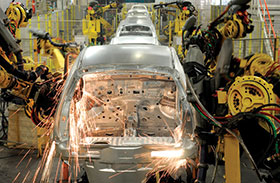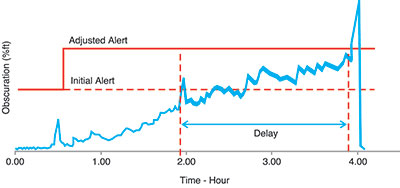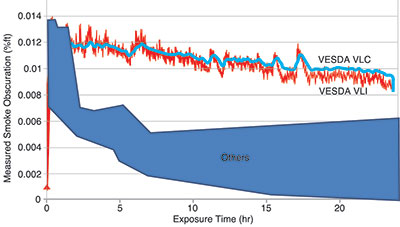

The ability to provide early and accurate alerts is the critical objective for any fire detection system and achieving that value is the primary challenge for our industry.
The earliest possible warning of any potential fire maximises the time available for local responders to assess the situation and take necessary action. This, in turn, minimises risks to life, property and business continuity. But early detection brings with it other, less obvious, benefits.
Quick, accurate assessment of potential fire situations ensures alarms reported upstream to emergency service responders are genuine. False or nuisance alarms from automated alarm systems are widespread, in some cases up to 90%, and costly to the community. They can also be costly to businesses with many municipalities levying fines against companies reporting false alarms.
Most importantly, however, false alarms mean that valuable emergency service resources and personnel are deployed needlessly, perhaps when the call for them elsewhere is genuine.
In short, improving fire detection is good business, and a mark of good corporate social responsibility. Choosing the most efficient and effective fire detection system requires selecting from a range of technologies, none of which is perfect.
False alarms: the cost to business
For the business owner, the cost of even a single false alarm can be substantial. In New South Wales, Australia, over 21 000 nuisance alarms occur every year with a fine of $750 levied against the property owner.
Staff have to be evacuated, and systems may have to be shut down. Customers and clients can’t or won’t make allowances for apparent emergencies so, inevitably, business is lost. There are also other, more insidious, effects. Too many false alarms may lead some businesses to isolate detectors. Frequent false alarms can cause staff to become complacent. The result, should a fire occur, could be disastrous.
Detector longevity and reliability are important considerations when selecting appropriate smoke detection systems. Performance can be affected by environmental conditions including dust, smoke, airborne particles, and plant wash-down. If a detector’s performance is affected by any of these conditions then lives, assets and business continuity are also put at risk.
Early and accurate detection must be allied with other considerations, including ease of installation and maintenance, and the cost of replaceable parts. Performance over time and in different environmental conditions must also be researched exhaustively.


Advantages and limitations of current ASD technologies
Aspirating smoke detectors (ASDs) operate by drawing air through sample holes in a pipe network into a detection chamber for analysis. ASD detectors are generally highly sensitive and provide very early warning of a potential fire at the incipient stage of fire development. Systems are monitored for airflow faults, providing warning if sample holes become blocked or a pipe is broken.
Most ASD systems provide multiple alarm levels that may be configured across a wide range of sensitivities. The benefit is earlier notification of a developing fire allowing investigation and manual intervention at the smouldering stage and, it allows for the subsequent activation of suppression release systems if required. This increases the time available for evacuation, and minimises potential fire damage.
Detection
Light scattering used in photoelectric or optical detectors is commonly found in point type and ASD detectors. This technology uses a light source, a lens to focus the light into a beam and a photodiode (or other sensor) angled to the beam to detect the scattered light in the presence of smoke. Commonly the light source used in an optical detector is an LED or laser.
Lasers emit organised or coherent light, allowing more accurate focusing of the light source and reduced drift over both temperature and time, eliminating the need for drift compensation. This yields a more reliable response to slow growth fires. The ability to better focus laser light sources also allows higher intensity light in the detection chamber and a higher sensitivity detector.
Some detectors use dual-wavelength optical detection technology, intended to distinguish between smoke and dust. In early stage smouldering fires, the size of dust and smoke particles can be similar, leading to large particle smoke being rejected as dust. Where the optical path is long and high sensitivity is secondary, such is the case with beam type detection, this method provides satisfactory performance.
Maintaining ASD performance
Industrial environments such as manufacturing, power generation, mining and even large cities often have high levels of background (ambient) smoke or dust. This can challenge some ASD systems, which must maintain reliable and consistent performance over time while avoiding nuisance alarms.
Different ASD technologies employ various techniques to address such environmental conditions including software algorithms or mechanical measures, such as filtration, to protect optics from contamination, compensate for drift and reduce nuisance alarms.
Optics protection:
ASDs may use external filtration to remove contaminants from sampled air before it enters the detector and ideally employ clean-air barriers to protect detector optics from contamination and degradation of sensitivity. Without clean-air barriers, some ASD systems employ drift compensation, relative sensitivity algorithms, or both.
Drift compensation
Smoke detectors which do not provide appropriate optics protection are vulnerable to contamination induced drift. Electronic components may also be subject to the effects of ageing, or in the case of some LEDs, temperature. To compensate for drift and minimise nuisance alarms, these detectors employ algorithms that ultimately make the detector less sensitive and may increase the time needed to detect smoke.
Drift compensation may force a near new detector to respond like a contaminated or aged detector when sampling in environments with near constant background pollution levels (Figure 1). Drift compensation may severely impact the sensitivity of a smoke detector and early warning reliability.
Relative sensitivity
Relative sensitivity or automatic alarm threshold algorithms modify alarm thresholds based on background smoke conditions in order to maintain a margin of safety from nuisance alarms. However, in slow-growth fire scenarios a detector may automatically adjust its alarm thresholds to a less sensitive level as very slowly increasing smoke levels are indistinguishable from background pollution or contamination. The result in tests has been delays approaching 2 hours (Figure 2) and may result in a potentially disastrous delay in detecting a real fire.
What’s missing from the ideal detector?
An ideal detector would provide accurate very early warning of fire events in the presence of high levels of nuisance alarms sources. Absolute calibration and detector stability are superior to drift compensation or relative alarm sensitivity. Fixed alarm thresholds and clean air barriers to protect the optics of a detector is the closest ASD has come to exhibiting absolute calibration and allowing stability at very low alarm thresholds over the life of the product.
An intelligent detector that could distinguish between substances such as dust, smoke and steam, could considerably reduce the time needed to accurately identify, verify and deal with an incipient event and mitigating loss. Similarly, the ability to fuse data, such as the presence of smoke and different gas species, would be a valuable decision support in emergencies.
Addressability combined with very early warning is another highly desirable feature in smoke detectors. ASD systems with addressability to 15 detection points are already able to provide very early warning of the exact location of an incident in facilities such as high-rise buildings, educational campuses and hospitals, aiding evacuation and minimising loss and downtime. The challenge is to help specifiers reconcile the initially higher capital cost with superior performance, utility and reduced operational expenditure.
The search for the optimum continues
At present no smoke detector on the market can match every challenge, although ASD comes close in many regards. Some of those challenges have been partially met, while others await even basic solutions. Additionally the wide range of codes and standards that need to be observed in the deployment and operation of VEW fire detection systems impose a multitude of requirements.
The combination of specific, aggregated and enriched data and improved connectivity would allow integration of intelligent detection to building management and other systems, including remote monitoring and verification, such that data from a multitude of sources can be used to create true, actionable information on threats.
Industry participants believe recent advances in technologies governing very early warning systems might soon provide the long-awaited game-changer. A flexible detection system, which combines very early warning fire and other data sources, may provide the next step in improving detection performance in challenging environments while nearly eliminating nuisance alarms.
For more information contact Derek Waddell, regional sales manager, Xtralis, +27 (0)82 316 2601, dwaddell@xtralis.com, www.xtralis.com

© Technews Publishing (Pty) Ltd. | All Rights Reserved.